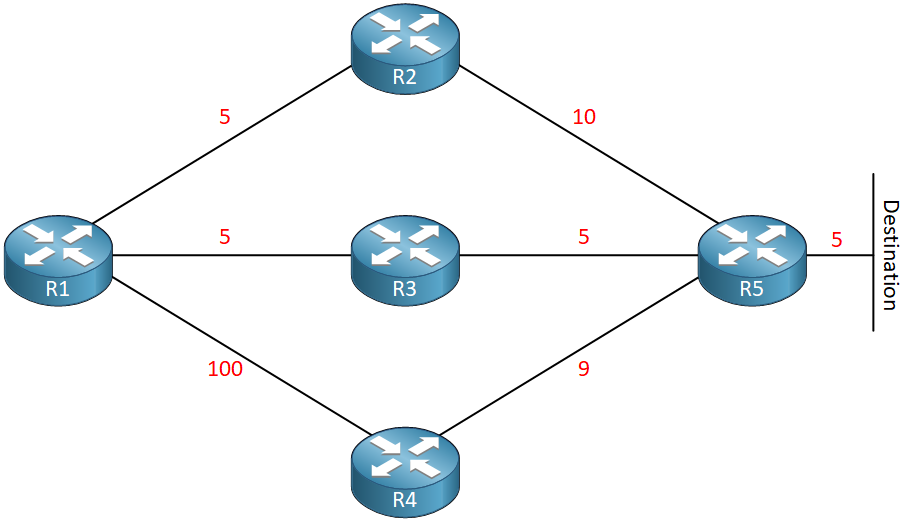Just like OSPF or RIP, EIGRP can do load balancing, but it has one more trick in its hat. RIP and OSPF both can do load-balancing, but the paths have to be equal.
EIGRP can do something cool…unequal load-balancing! Even better it will share traffic in a proportional way, if you have a feasible successor that has a feasible distance that is 5 times worse than the successor, then traffic will be shared in a 5:1 way.
Let’s take a look at an example of how EIGRP can do load balancing:

We’ll view this topology from R1’s perspective. Let’s fill in the successor, feasible successor, advertised, and feasible distance in a table. If you have no idea how this works, please read my introduction to EIGRP first.
|
Advertised Distance |
Feasible distance |
|
|
| R2 |
15 |
20 |
|
| R3 |
10 |
15 |
SUCCESSOR |
| R4 |
14 |
114 |
FEASIBLE SUCCESSOR |
This is our first example where we found out the successor and feasible successor. If you look at the routing table, you will only find the successor there. Now we are going to change things so we’ll see the feasible successor in the routing table as well so it will load-balance.
You can do this by using the variance command. The variance command works as a multiplier:



Thanks Paul, I just rewrote it a bit.
Rene,
Hi. If we set the variance to 11 it will begin load-balancing, but can you reconfirm the proportion it will be performing this (i.e. 11:1)?
Many thanks,
Thomas
Hi Thomas,
I think this will be useful, it’s a configuration example:
https://networklessons.com/eigrp/eigrp-variance-command-example
The variance command is used to define which feasible successors will be used for load balancing but it doesn’t tell the router which proportion to use. The proportion is based on the feasible distance of the EIGRP routes that were placed in the routing table.
Rene
Hi Rene,
If we have three path to destination and we configure variance to use the three path just like in your example here :-
https://networklessons.com/eigrp/eigrp-variance-command-example
My question is :-
The traffic will be shared in which way ? to be more clarify, In the begging of this article you said " if the feasible successor has a feasible distance which is 5 times worse than the successor then traffic will be shared in a 5:1 way " so what the rate will be if we have three path to destination ( the successor and tow feasible successors ) ?
Hi Hussein,
It will be shared in proportion based on the feasible distance. If the successor had a FD of 100 and the feasible successors had a FD of 20 and 10 then you’d see a 10:2:1 ratio.
Rene